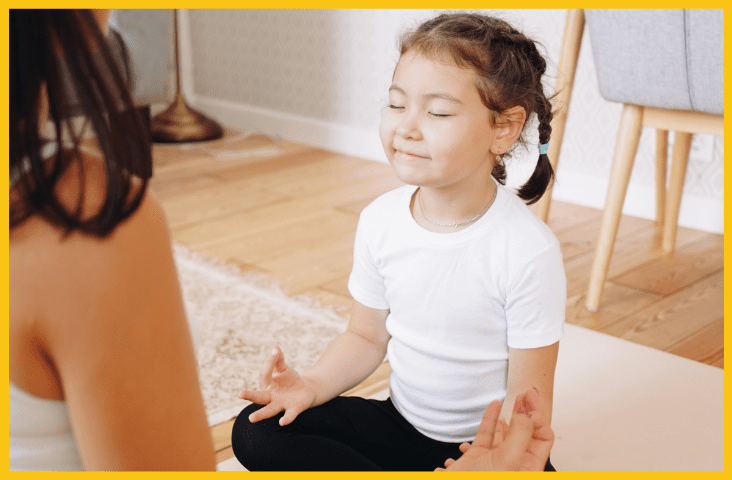
5 mindfulness activities to help your child with BIG feelings
Do you have a little person with BIG feelings? A child who seems to feel things intensely, gets triggered often, and has lots of tantrums, meltdowns or outbursts? A child who has big expressions of anger, frustration, anxiety, or disappointment?
I hear you. So many of the families I see in my practice are dealing with BIG feelings from little people. And it can be really tough to support your child with these big emotions and to know how to help them. Especially if you are parenting differently to the way you yourself were raised, and you never had anyone model these skills for you.
It can sometimes feel like you are in way over your head.
But of course, your child is never going to grow out of having emotions. So learning some strategies to help them process those big emotions is essential.
Mindfulness and emotions
I am a huge proponent of teaching children mindfulness to help them with emotional regulation. Mindfulness involves being aware of internal experiences without judgment. Which means it allows children to tune into their emotions, as well as the thoughts and physical sensations that accompany them, without getting carried away, buying into them or judging them as good or bad. It allows them to just notice and acknowledge how they feel. This development of self-awareness means they can then make an intentional choice about how to behave in response to that feeling, instead of just impulsively reacting or lashing out every time they feel an intense emotion.
Here are some exercises to get you started.
5 Mindfulness exercise to help your child with big feelings
1) 5, 4, 3, 2, 1
I love this exercise because you can do it just about anywhere and it really doesn’t require any special equipment. All your child needs to do is to notice what is happening around them using each of their 5 senses.
First, they name 5 things they can SEE. Ask your child to look around them and bring their attention to 5 different items they can see. You might like to ask them to choose things they wouldn’t normally notice, like a mark on the wall, or a small crack in the concrete.
Then they name 4 things they can FEEL. Ask your child to notice 4 things they can touch or feel. It might be the texture of their clothes against their skin, the chair against the back of their legs, a toy they are holding in their hands, or their hands resting in their lap.
Next they name 3 things they can HEAR. Ask them to be very quiet for a moment and tune into the noises around them. They might hear voices in the background, traffic going past, the whir of a ceiling fan or the hum of the fridge!
Then they name 2 things they can SMELL. Ask your child to bring their awareness to the smells around them. It could be the smell of food cooking, an air freshener hanging in the car, the ocean, or some flowers nearby. It could even be the scent of washing powder on their clothes.
And finally, they name 1 thing they can TASTE right now. This one can be tricky sometimes, depending on where your child is and what’s been happening. But they may have a snack they can pop in their mouth, a water bottle to take a sip of, some gum to chew, or they may even be able to taste some remnants of toothpaste in their mouth!
Helpful for:
This exercise is a great one for children who are feeling anxious and stuck in their heads, following a cycle of negative thinking. By focusing on their 5 senses, it very quickly grounds them and brings them into the present moment. You cannot be thinking about other things while completing this exercise – you simply must be fully present and engaged with the activity! If you have a child who experiences panic attacks or becomes very anxious in certain situations, this is a helpful exercise to teach them.
2) Body Scan
A body scan is a fantastic exercise to help children link their emotions with the physical sensations they experience. You can use this activity purely as an exercise in developing self-awareness, starting at the top of the head and asking your child to notice the sensations they can feel. For example, is their head achy, can they feel tension, are they clenching their jaw? Then slowly move down the body, just bringing their awareness to the sensations in their neck, their shoulders, their arms, stomach, legs and feet, pausing for a few moments at each body part to allow your child to notice the sensations they feel there.
This activity can also be used to help your child relax their body, particularly at bed time. Simply ask your child to lay still in bed and close their eyes, while you bring their attention to each body area, again, starting at the head and working down towards the toes. Invite your child to focus on relaxing each body part or area before moving to the next one.
Helpful for:
This exercise is helpful for children who struggle with self-awareness and interoception – noticing sensations within their body. You can use this activity to bring your child’s attention to the fact that all emotions have physical sensations that accompany them. This helps them start to notice these more, so they can use the cues from their body to identify how they feel before they lash out or lose control.
3) Progressive Muscle Relaxation (PMR)
This activity is similar to a body scan, in that you will encourage your child to start at their head and gradually move the focus from there, to all of their major body parts, ending at the feet. But this time, you will ask your child to tense each muscle group for a few moments before relaxing it, and bring their awareness to the change in sensation and how their body feels when they relax. This helps children better tune into the physical experience of emotions in the body. Many children (adults too!) are so chronically stressed that they do not realise they are holding tension in their body until someone asks them to release it.
Helpful for:
PMR is especially useful for children who struggle with anger. It helps them to really tune into the sensations of tension and muscle tightness that tend to accompany this emotion. Again, so they can begin to read the cues their body is sending them about how they feel. With practice, children can do a release only version of this activity, simply bringing attention to any tense muscles and intentionally relaxing them in order to better manage their anger.
4) Smell the flower, blow out the candle
This is a very simple but effective mindful breathing activity that helps to activate the parasympathetic nervous system – the branch of the nervous system responsible for switching off the stress response. The activity helps children to master the correct breathing technique, taking a deep breath in through the nose, all the way down to the stomach, and then a nice long breath out through the mouth, releasing all the air again.
To do this activity, simply hold a finger up in front of your child, or ask them to do it themselves. They are to imagine that the finger is a beautiful smelling flower, and they will take a deep breath in through their nose as they smell the flower. Then they will imagine that the finger is a candle, as they will take a big breath out through their mouth, so they can blow the candle out. Have them repeat this activity a few times, until they appear visibly calmer.
Helpful for:
This exercise is helpful for a child who is feeling overwhelmed by any big emotions and is showing signs of physiological stress – things like rapid breathing, shortness of breath, dizziness, or headaches. It will quickly lower their heart rate and respiration rate, and decrease the physiological arousal they were experiencing.
5) Mindful Mantras
Mantras are an exercise that can help prevent children from getting stuck in and overwhelmed by negative thinking. When children experience negative thinking and get caught up in believing these thoughts, they can then be flooded by big emotions that quickly overwhelm them and lead to challenging behaviours. Mantras are a helpful way to remind children that they are in control of their own thoughts and that they have the power to calm themselves down.
Helpful mantras children can use might include:
“I can handle this”
“My thoughts are not facts”
“I can use my breath to calm my body”
Helpful for:
Mantras are particularly helpful for children who get stuck in negative patterns of thinking that cause them to spiral into overwhelm and trigger more big emotions like guilt and shame. Children need lots of practice with mantras while they are calm and settled, so they can use them effectively when they begin to feel big emotions. But with practice, they can be a very effective mindfulness tool.
Sarah Conway is a child and adolescent psychologist, mother of 4, and founder of Mindful Little Minds. She has over 15 years of experience working in mental health with children, teenagers, and families. Sarah’s mission is to help parents move away from punitive parenting strategies and towards mindful, intentional parenting that builds emotional intelligence in kids and parents alike. As a busy mum herself, she knows firsthand how difficult mindful parenting can be, particularly when it was never modeled by our own parents. That’s why she provides parents and children with simple, practical strategies and tools that help them learn to manage emotions – together. She believes that changing the way we parent will change the world.







